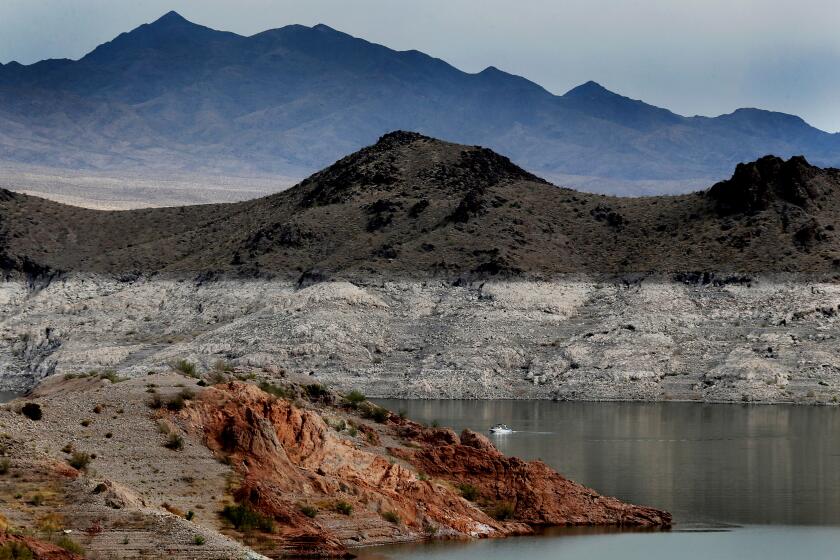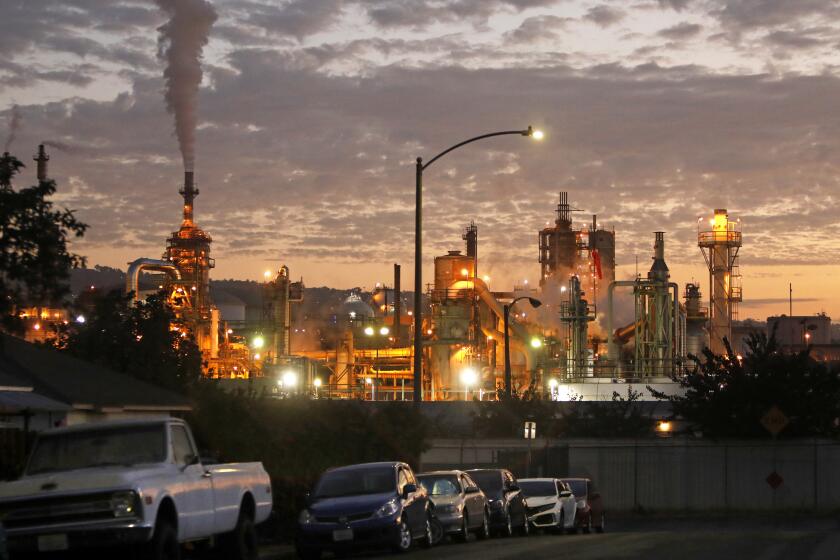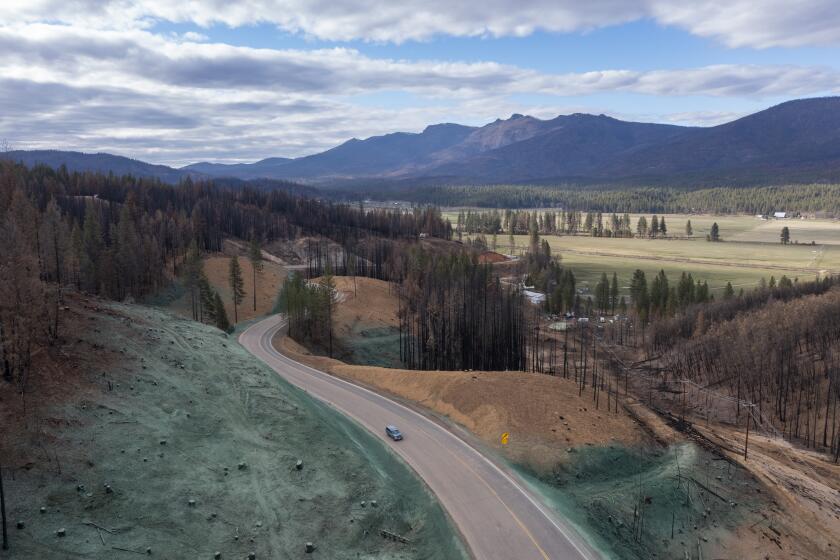California drought official quits, blasting Newsom for ‘gut wrenching’ inaction

- Share via
In his time at the California State Water Resources Control Board, Max Gomberg has witnessed the state grapple with two devastating droughts and the accelerating effects of climate change.
Now, after 10 years of recommending strategies for making California more water resilient, the board’s climate and conservation manager is calling it quits. The reason: He no longer believes Gov. Gavin Newsom and his administration are willing to pursue the sorts of transformational changes necessary in an age of growing aridification.
In a resignation note posted online this month, Gomberg accused the governor of siding with defenders of the status quo and also faulted those in his agency who failed to push back.
“Witnessing the agency’s ability to tackle big challenges nearly eviscerated by this Administration has been gut wrenching,” Gomberg wrote. “The way some of you have simply rolled over and accepted this has also been difficult to watch.”
Recurring drought and rising temperatures have already begun to alter the landscape of California and the American Southwest, researchers warn.
In an interview with the Los Angeles Times, Gomberg said he went public with his criticisms after encountering resistance to a “long list” of proposals, including assistance for low-income ratepayers, ways of bolstering water conservation, new water agency permit requirements related to climate preparedness, and the addition of climate requirements to strengthen water regulation and management.
“We’re really, as a society at this point in time with climate change, in need of bigger, bolder action. And we’re not getting it,” Gomberg said. “Being in an agency that could be part of that, taking big and bolder actions, and being told that those options are not on the table, was intolerable.”
Newsom’s office has rejected Gomberg’s criticisms.
“This Governor is doing more than any other state to adapt to our changing climate,” said Erin Mellon, a spokesperson. She said that when Newsom first took office, he prioritized changing the way in which California approached its water challenges.
“The Governor has worked with the legislature to invest $8 billion to implement the strategies in the Water Resilience Portfolio, which focuses on diversifying our water supplies, enhancing ecosystems, improving infrastructure and ensuring California is better able to manage hotter and drier weather,” she said.
California is embracing carbon capture and storage technology to fight global warming, but critics say it will only increase oil production.
Gomberg, 43, said he has been unhappy with the Newsom administration since the governor took office and removed Felicia Marcus as water board chair. Gomberg said her removal signaled “a retreat from using the board’s regulatory authority” after Marcus had led the board’s push for cities and irrigation districts to divert less water from heavily used tributaries of the San Joaquin River.
“This governor, this administration does not like having independent regulatory agencies. They want to sort of control everything,” Gomberg said. “The direction comes from the top.”
Gomberg said he thinks the board, now led by chair E. Joaquin Esquivel, has since been “allowed a much narrower range of regulatory actions” and has been directed to pursue “nonregulatory approaches on just about everything.”
Asked to respond, Esquivel defended the board and its staff, saying the agency has taken unprecedented steps to address the drought.
“Every day, the State Water Board makes tough decisions to protect and manage California’s limited water resources by listening to the perspectives and needs of the state’s diverse stakeholder communities,” Esquivel said. “Over the past year, the Board has taken unprecedented, bold, real-time regulatory actions in response to the state’s drought emergency, including implementing the broadest water rights curtailments in history; has voted to pass one of the strongest antiracism state resolutions ever adopted; and has begun implementation of the Bay-Delta plan for the lower San Joaquin River Bay-Delta.”
An increase in catastrophic wildfires has reduced California tree cover by 6.7% since 1985, and researchers fear the lost trees will never grow back.
Gomberg did praise the board’s work in committing to a racial equity plan and taking steps to address longstanding inequities, but said he thinks the water rights system, which benefits those who diverted water first and staked their claims more than a century ago, is “fundamentally unjust and unsuited to contemporary challenges brought on by climate change.”
“There is no equitable approach to water management that doesn’t undo that system,” said Gomberg, who has started working as a water policy consultant.
Gomberg said a high point for the administration came with the governor’s signing of a law that created a fund to pay for water projects in communities with contaminated water.
However, he condemned the administration’s approach of pursuing so-called “voluntary agreements” with major water suppliers to secure flows for the deteriorating ecosystem of the Sacramento-San Joaquin Delta. He said that has been a “huge waste of time” and has brought delay.
Gomberg said the state has been too slow and cautious on conservation measures in cities. He said he thinks the administration has failed to address inequities in the water rights system, has left intact an excessive two-decade timeframe for fully implementing groundwater regulation, and has supported the “perpetuation of status-quo power structures,” with local groundwater agencies now dominated by representatives of irrigation districts and agricultural interests.
“The people in charge of those agencies have the least incentive to move quickly,” Gomberg said. “They fully intend to run out the clock and fight any state attempt to come in and get into their business.”
As climate change brings more extreme dryness in the West, Gomberg said, the administration has shown “zero inclination” to pursue a balancing of agricultural water use and the water needs of the environment and rural communities.
On average, agriculture consumes nearly 80% of the water that is pumped and diverted each year.
“I think California needs an agriculture policy,” Gomberg said. “The de facto policy is cheap food, as cheap as possible. Don’t do anything that would in any way impinge on the ability of people growing any kind of agricultural product to grow as much as they want, where they want, with however much water they want.”
As groundwater levels decline in many farming areas, wells that people depend on in nearby communities are at risk. According to state records, more than 4,500 household wells have been reported dry in California since 2015, including 699 wells so far this year, many in the Central Valley.
Gomberg said that California’s overlapping water systems — including the water rights system, longstanding water allocations, groundwater regulations and rules on well-drilling permits — have allowed for a level of agricultural output that chronically overdrafts water supplies.
“There are the zillions of acres of almonds and grapes. It’s not sustainable,” Gomberg said. “Everyone knows it’s not sustainable, just like everyone knows the amount of withdrawals from the shrinking Colorado River system are not sustainable. But it’s almost like it’s a game of chicken right now. Everyone’s waiting for someone else to blink.”
More to Read
Sign up for Essential California
The most important California stories and recommendations in your inbox every morning.
You may occasionally receive promotional content from the Los Angeles Times.














